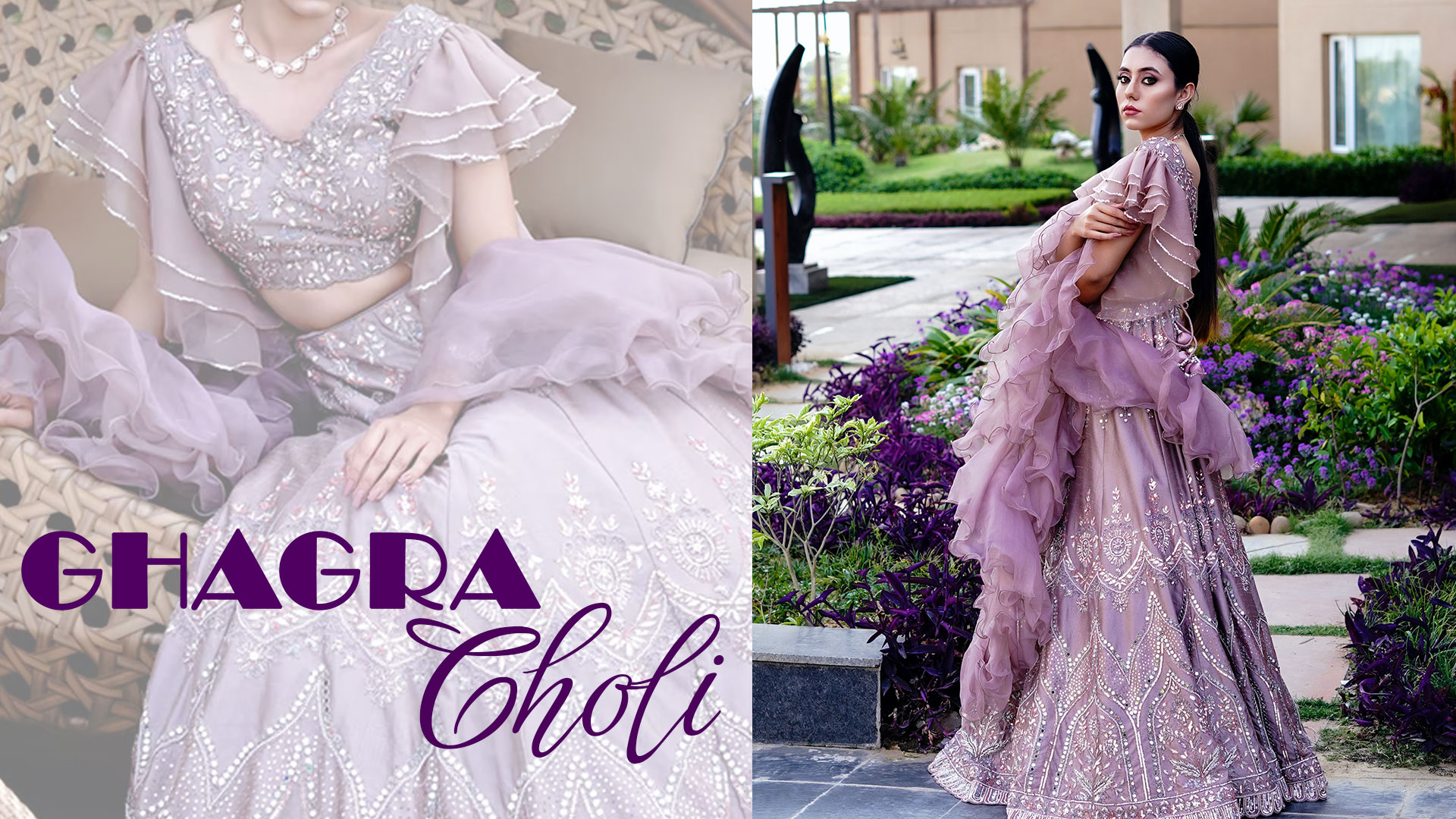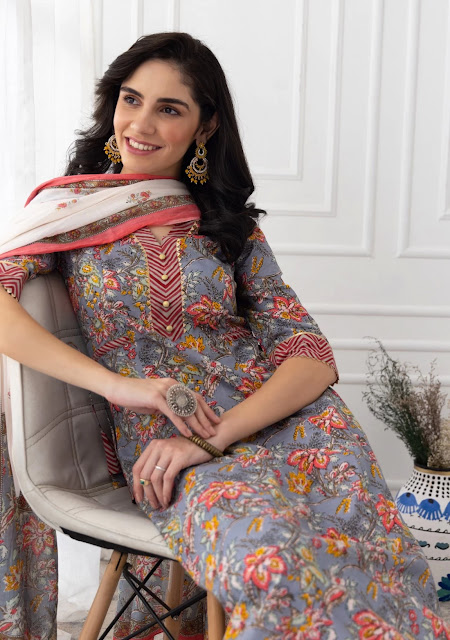History and evolution of Ghagra choli
India's fashion industry is a treasure trove of fascinating garments, materials, and design variants. The immense size and impact of India’s culture, history, and geography pervade all aspects of Indian society, including fashion.
Although many traditional Indian clothing has a vast and famous history, nothing compares to the Choli and ghagra in terms of brilliance and appeal. Ghagra choli’s has been an integral part of Indian fashion history.
The ghagra choli has a long history
The Ghagra's origins can be traced back to the Mughal Empire, it was worn by women during that time. It blossomed throughout this time and swiftly became the most popular garment not only among the noble and women of the upper class, but also among the general populace. The origins of the Ghagra are unknown, but one thing is certain: it quickly became the most popular clothing
This garment swiftly became the most popular dress form for ladies of all ages and social classes in locations like Rajasthan and Gujarat. It has had a long and tumultuous history, the ghagra choli's design has evolved significantly.
In a variety of small ways, today's clothing differ from those that were adorned moons ago. There are a wide range of styles available, from timeless classics being worn in Rajasthani villages to cutting-edge futuristic designs seen on fashion lamps and the red carpet. This is owing to the fact that Indian designers have broadened their business and design scope over the previous few decades.
As a result, many designers are looking back through the history of the Ghagra choli to uncover and resuscitate the pride of spectacular classic patterns that have been out of trend for many years. Unique Western aesthetics are also incorporated to create stylish fusion combinations.
Choli is a fitted blouse that is worn over a long skirt that can and cannot be without pleats and has a drawstring to secure the waist. It usually exposes only a small area of the waist. It is finished with a heavy and long dupatta delicately covered over the garment to add beauty and humility.
Today, of course, one can find a tremendous variety thus you can easily do ghagra choli online shopping. You can choose from ornately designed designer Ghagras to vibrant festival Ghagras. Depending on the silhouette, the skirt's style may change. The seductive mermaid skirt is fitted to the knees and gracefully flared. The aligned skirt has a straight, western-style design, whereas the circular Ghagra has a huge, voluminous, and structured drape.
The mother of all Indian ensembles is the ghagra choli
The narrative of a ghagra choli isn't always straightforward. In reality, it's more of a "many garments" story than a single one. The emergence of a voluminous, circularly cut Ghagra can be seen in the history of Ghagra Choli from Rajasthani attire. The modest Patupavada, worn by little girls in southern India, has a long history that dates back to the introduction of silk weaving in the region. As a result, there are many fascinating regional aspects to India's Ghagra history.
In the history of wedding lehenga, one of the places where the severe evolution of design has not been witnessed is. They appear today to be just as rich, complex, and magnificent as they were during the Maharaja and Nawab eras. In addition to the classic red, pink, and green colours, designers have recently begun to integrate unexpected colors like cream, ivory, gray, and even black.
The spectrum of styles and patterns has altered and expanded over the history of Ghagra chori.
Rich gold thread designs are the most popular, but other forms such ' buti works, cutdana, and ' buti works, gotapati are intricate and complicated with various intricate designs. Art and nature are commonly used to produce one-of-a-kind designs, which are often inspired by them.
When it comes to fabrics, silk and cotton are still classic choices. Nowadays, chiffon, georgette, and crepes are also used. To create a stunning formal wear Ghagra choli, mesh, velvet, textiles, and other rare materials are frequently piled.
Although many traditional Indian clothing has a vast and famous history, nothing compares to the Choli and ghagra in terms of brilliance and appeal. Ghagra choli’s has been an integral part of Indian fashion history.
The ghagra choli has a long history
The Ghagra's origins can be traced back to the Mughal Empire, it was worn by women during that time. It blossomed throughout this time and swiftly became the most popular garment not only among the noble and women of the upper class, but also among the general populace. The origins of the Ghagra are unknown, but one thing is certain: it quickly became the most popular clothing
This garment swiftly became the most popular dress form for ladies of all ages and social classes in locations like Rajasthan and Gujarat. It has had a long and tumultuous history, the ghagra choli's design has evolved significantly.
In a variety of small ways, today's clothing differ from those that were adorned moons ago. There are a wide range of styles available, from timeless classics being worn in Rajasthani villages to cutting-edge futuristic designs seen on fashion lamps and the red carpet. This is owing to the fact that Indian designers have broadened their business and design scope over the previous few decades.
As a result, many designers are looking back through the history of the Ghagra choli to uncover and resuscitate the pride of spectacular classic patterns that have been out of trend for many years. Unique Western aesthetics are also incorporated to create stylish fusion combinations.
Choli is a fitted blouse that is worn over a long skirt that can and cannot be without pleats and has a drawstring to secure the waist. It usually exposes only a small area of the waist. It is finished with a heavy and long dupatta delicately covered over the garment to add beauty and humility.
Today, of course, one can find a tremendous variety thus you can easily do ghagra choli online shopping. You can choose from ornately designed designer Ghagras to vibrant festival Ghagras. Depending on the silhouette, the skirt's style may change. The seductive mermaid skirt is fitted to the knees and gracefully flared. The aligned skirt has a straight, western-style design, whereas the circular Ghagra has a huge, voluminous, and structured drape.
The mother of all Indian ensembles is the ghagra choli
The narrative of a ghagra choli isn't always straightforward. In reality, it's more of a "many garments" story than a single one. The emergence of a voluminous, circularly cut Ghagra can be seen in the history of Ghagra Choli from Rajasthani attire. The modest Patupavada, worn by little girls in southern India, has a long history that dates back to the introduction of silk weaving in the region. As a result, there are many fascinating regional aspects to India's Ghagra history.
In the history of wedding lehenga, one of the places where the severe evolution of design has not been witnessed is. They appear today to be just as rich, complex, and magnificent as they were during the Maharaja and Nawab eras. In addition to the classic red, pink, and green colours, designers have recently begun to integrate unexpected colors like cream, ivory, gray, and even black.
The spectrum of styles and patterns has altered and expanded over the history of Ghagra chori.
Rich gold thread designs are the most popular, but other forms such ' buti works, cutdana, and ' buti works, gotapati are intricate and complicated with various intricate designs. Art and nature are commonly used to produce one-of-a-kind designs, which are often inspired by them.
When it comes to fabrics, silk and cotton are still classic choices. Nowadays, chiffon, georgette, and crepes are also used. To create a stunning formal wear Ghagra choli, mesh, velvet, textiles, and other rare materials are frequently piled.






Comments
Post a Comment